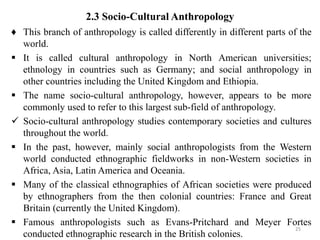This document provides an overview of anthropology as a field of study. It defines anthropology as the study of human beings, their biological and cultural characteristics, and variations and similarities across time and place. The document traces the historical development of anthropology from its roots in ancient Greek philosophy through its emergence as a modern academic discipline in the late 19th century. It describes the broad scope of anthropology, covering all aspects of human existence, and its unique holistic and relativistic approach. Common misconceptions about anthropology are addressed, and its relationships with other social sciences are discussed. The contributions of anthropology in providing cultural understanding and solutions to societal problems are also outlined.














![1.4 The Relationship Between Anthropology and Other Disciplines
• Anthropology is similar with other social sciences such as sociology,
psychology, political sciences, economics, history, etc.
• Anthropology greatly overlaps with these disciplines that study human
society.
• However, anthropology differs from other social sciences and the
humanities by its broad scope, unique approach, perspective, unit of
analysis and methods used.
• In its scope, anthropology studies humankind in its entirety.
• In its approach, anthropology studies and analyzes human ways of life
holistically, comparatively and in a relativistic manner.
• The perspective is also fundamentally empirical, naturalistic and
ideographic [particularising] than nomothetic [universalising] one.
• In its method of research, it is unique in that it undertakes extended
fieldwork among the study community and develops intimate
knowledge of the life and social worlds of its study group/society
through employing those ethnographic data collection techniques such
as participant observation, key informant interview and focus group
discussions.
15](https://image.slidesharecdn.com/anthropologymodule-240118124753-51a48ee1/85/Anthropology-Module-pptx-15-320.jpg)








































































![Cont.…
• It refer to a body of empirical knowledge and beliefs handed down
through generations of long-time inhabitants of a specific locale, by
cultural transmission, about the relationship of living beings with
each other and their environment (Warren 1991).
• In sum, IKS refers to a total of knowledge and practices, whether
explicit or implicit, used in the management of socioeconomic,
ecological and spiritual facets of life (Hoppers, 2005: 2), stored in
the collective memory and communicated orally among members
of the community and to the future generations [through, stories,
myth, songs, etc].](https://image.slidesharecdn.com/anthropologymodule-240118124753-51a48ee1/85/Anthropology-Module-pptx-88-320.jpg)





